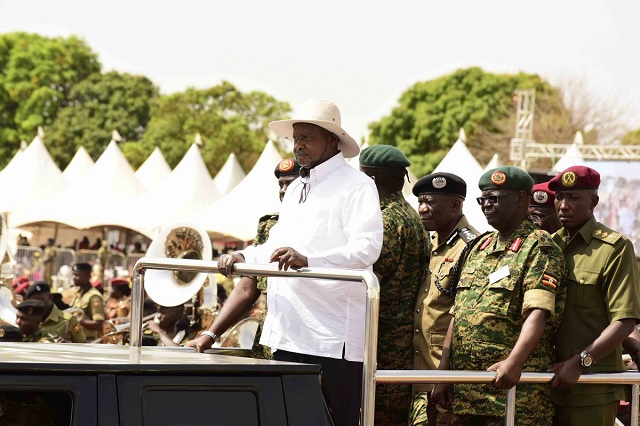
Kampala, Uganda | THE INDEPENDENT | This week, the Uganda People’s Defence Forces (UPDF) held a series of events to mark 38 years since the start of the war that brought President Yoweri Museveni to power in January 1986.
The events to celebrate Tarehe Sita climaxed on Wednesday in Kitgum district. General Museveni was in a combative mood at Kitgum Primary Teachers’ College, the venue of the main event, warning that the army has built enough capacity to handle any threat.
“Nobody can disturb our peace. Anyone who thinks of destabilising Uganda will destroy themselves…they will be defeated and destroyed,” he said.
Museveni said clear political orientation, with patriotism and Pan-Africanism, were key pillars to building the UPDF to the current professional standard.
The Tarehe Sita event dates back to February 6, 1981, when Yoweri Museveni led 27 armed men to attack Kabamba military barracks in Mubende district. It is this attack that launched the five-year “Luweero Bush War” that brought President Museveni to power on January 26, 1986.
For at least 33 years February 6 is celebrated annually.
Museveni’s emphasis on Uganda’s military capability connected Tarehe Sita to another historical event, 53 years ago, that might be a major factor in the militarization of Uganda’s politics.
In a two-part series, Uganda Radio Network revisits some of the events of 1966 that laid the foundation for successive leaders to always turn to the military to answer questions of political nature.
Another February, another event
While February 6 shaped the political events in Uganda from the 1980s, it was another “February event” 15 years earlier that, perhaps, changed the trajectory of the country’s history and cultivated a fertile ground whose fruits include the Kabamba incident.
On February 4, 1966, a legislator tabled a motion in the Parliament of Uganda seeking to have Prime Minister Milton Obote, two of his ministers and deputy Army Commander, Col. Idi Amin, suspended for corruption.
This motion is partly responsible for the direction that Uganda took, including abrogation of the constitution in 1966, two military coups in 1971 and 1985, a civil war in 1978-1979 and another war from February 6, 1981 to January 26, 1986.
Ocheng motion
In January 1966, Daudi Ocheng, a Member of Parliament for Mityana and secretary general for Kabaka Yekka (KY) party, made revelations that were to change the course of history that year. According to Ocheng, also a personal friend of President Edward Mutesa, top government officials, including Prime Minister Obote, were personally receiving gold, ivory and money from rebels in neighbouring Congo. The other officials mentioned were Defence Minister Felix Onama, Economic Planning Minister Adoko Nekyon and deputy army Chief, Col. Amin. The post-independence Uganda government was secretly supporting Christophe Gbenye, a rebel leader in Congo whose forces were fighting the regional government of Moise Tshombe. Amin was the officer coordinating the activities.
Amin’s fat account
In his 1970 book, The Uganda Crisis, Akena Adoko summarises the events starting with Ocheng’s allegation in January 1966 that a sum of 340,000 shillings had been deposited on Col. Amin’s bank account in Ottoman Bank. According to Ocheng, the money was deposited within 24 days in the months of February and March 1965.
In his November 1968 article, “Myths and Realities: A letter to a London Friend,” Dr Obote says he chaired a UPC Parliamentary Group meeting on January 31, 1966 during which a party position was adopted. All UPC members in parliament were to oppose the motion on the floor of parliament. After the meeting, Obote left for a tour of northern Uganda that would take him to Acholi and West Nile.
Enter Ibingira
This was not to be, as Justice Minister Grace Ibingira, with whom Obote was jostling for the control of UPC party, convinced several MPs to support the motion. Writing in “The New African”, a South African magazine in March 1967, Andre de la Rue paints a picture of a fractious, intrigue-riddled ruling party at the time of the motion. Rue traces the divisions to early 1964 when Ibingira defeated John Kakonge for the position of UPC secretary general by a difference of only two votes. Ironically, Obote supported Ibingira against Kakonge.
In the absence of Obote, therefore, it might have been easy for Ibingira, on February 4, 1966, to lead the cabinet in reversing a key decision of the party. Indeed, only John Kakonge opposed the motion.
 The Independent Uganda: You get the Truth we Pay the Price
The Independent Uganda: You get the Truth we Pay the Price



A very interesting article about my father. May his soul rest in eternal peace